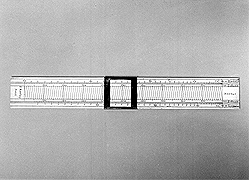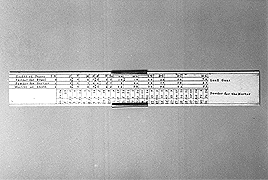 Fig. 59
Fig. 59  Fig. 60
Fig. 60
Signed: I Rowley fecit
c. 1700
As mathematical instrument maker to the English Board of Ordnance in the early 18th century, John Rowley was accustomed to making instruments and gauges for artillery. However, this rule is not a standard-issue device. Its most distinctive feature is the diagonal scale labelled 'Mortar' which relates the range of a shot to elevation. The scale is based on a table of horizontal mortar distances by Robert Anderson, a mathematically-inclined silk-weaver of London, who published his The Genuine Use and Effects of the Gunne in 1674 (Appleby, p. 3). Anderson's table was reprinted by John Harris in his Lexicon technicum (first edition, 1704) under the heading 'Mortars' and a note was added:
Since this, our Excellent Mathematical Instrument-maker, Mr. John Rowley, hath contrived this Table on a Scale of Box, where, by sliding only a fiducial Edge of Brass over the Diagonals of the Distance required, both the Elevations, upper and lower, are shewn at the same time.
The example shown here uses more impressive materials: ivory rather than box for the rule and silver rather than brass for the sliding cursor. In use, the rule provides a graphical solution to the problem of ranges. Given the range of a particular piece at a given elevation, a gunner could work by proportion to find the range at any other elevation and vice versa.
The reverse of the instrument carries more familiar material in the form of two tables for shot and powder. One gives the weight of shot and the amount of powder (for both proof and service) for artillery pieces; this provides simply an abbreviated version of the data on the Jobson folding rule (catalogue no. 3). The second table indicates the weight of powder required for mortars of different diameter; Rowley has again relied here for his information on the work of Robert Anderson.
Length: 249 mm
Orrery Collection (Christ Church)
Inventory no. 47,160